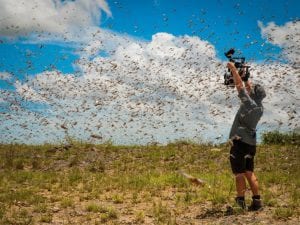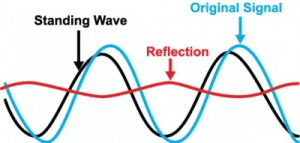Like a locust super-swarm in Madagascar, similar to a scene in BBC America’s “Planet Earth II” (image 1), commercial and government programs alike are aiming to employ “swarms” of UAV’s in domestic and overseas operations2. This includes counter-UAS systems, intelligence, surveillance, reconnaissance, near-space and hurricane hunting drones. Swarms of UAVs can be controlled through autonomous UAV synchronization and formation flight, requiring minimal sensor operators. The drone swarm’s small footprint makes it easy to deploy from all platforms: ships, vehicles, and aircraft. Not to mention, many of these systems are low cost and expendable compared to typical fighter jet platforms used to combat similar adversaries.

This robotic technology is so important to the DOD’s current operations tempo that, in June 2018, the Office of Naval Research (ONR) awarded Raytheon Co. (Tucson, Arizona) a $29,688,168 cost-plus-fixed-fee contract for further development in their Low-Cost UAV Swarming Technology (LOCUST) Innovative Naval Prototype (INP). This program included a tube-based launcher that sends UAV’s into the air in rapid succession.3 ONR recently shared a video of this demonstration which can be viewed here.
Internationally, China has also taken notice of this technology, seeing its benefits in the development of anti-stealth drones, high altitude airships, and hypersonic spy planes. In June 2017, China Electronics Technology Group Corporation (CETC) successfully launched a swarm of 117 drones. CETC, on a separate project, teamed with Tsinghua University to launch an unarmed drone swarm which hunted an enemy missile launcher in an urban area by dive-bombing and destroying it (shown through CGI sequence).1
The future of “Swarming Technology” is open and still somewhat theoretical as more funding is poured into the programs to develop this biblical plague of robots. The race is on to provide our current warfighters the competitive advantage in the battlefield. Instead of our Soldiers, Airmen, Sailors and Marines running into the battlefield, these drones can precede troops on the ground or aircraft overhead. This in turn will allow the drones to detect enemy ahead, report potential hazards, jam enemy communications, and draw fire expending enemy resources to save lives and conserve military resources. Furthermore, reducing the number of required missions, the number of military assets on the front lines to include troops and overall increasing combat power.

What does this mean for the future of RF and Microwave Systems? Well, if you draw the lines of relative elements in the Venn diagram for drone platforms and RF & microwave systems, there are some overarching terms. All of these terms fall right in line with NuWaves’ line of commercial off-the-shelf (COTS) RF power amplifiers, bidirectional amplifiers, low noise amplifiers, frequency converters, custom filters, and broadband pre-selectors. Our COTS product lines are miniaturized to fit compact drones, ruggedized to handle large accelerations during drone launch, and ready to be customized to meet the stringent range and power requirements for autonomous flight. If our COTS products aren’t the best fit, we offer design engineering services to serve your project from concept to production. We are a design powerhouse with over 25+ highly skilled RF and digital engineers, as well as 10+ highly technical project management staff ready to provide a superb US-based customer experience (CX). Our close-knit team works with UAV integrators at all levels to provide the best RF solution, well within the customer’s specifications, budget, and delivery schedule. Our location in Middletown, Ohio (between Cincinnati and Dayton) provide us a strategic response time to our East and West Coast partners, as well as our partners abroad.
Reach out to our Product Solutions team today to schedule a no obligations review of your specifications. Our ultimate mission is to deliver high-technology Engineering Services and Product Solutions, so don’t be concerned with being added to another sales team’s list. Let’s engineer a lasting partnership and advance the technology our current warfighters!
References:
- Lin, Jeffrey, and P.W. Singer. “China Is Making 1,000-UAV Drone Swarms Now.” Popular Science, 8 Jan. 2018, popsci.com/china-drone-swarms.
- Praderio, Caroline. “It’s Surprisingly Difficult to Find a Swarm of One Billion Locusts.” INSIDER, INSIDER, 10 Mar. 2017, thisisinsider.com/how-planet-earth-ii-filmed-locust-swarm-2017-3.
- Smalley, D. (2015, April 14). LOCUST: Autonomous, swarming UAVs fly into the future. Retrieved October 22, 2018
- Suppressing Air Defenses by UAV Swarm Attack [Digital image]. (n.d.). Retrieved October 22, 2018, from https://www.uasvision.com/2018/06/28/suppressing-air-defenses-by-uav-swarm-attack/


